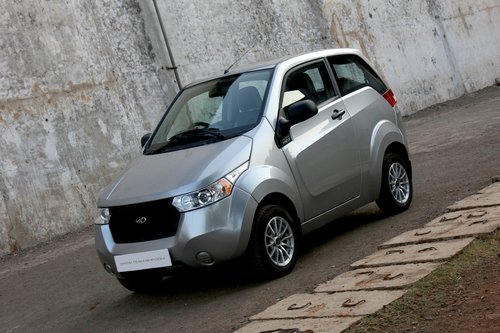| |||||||
| Search Forums |
| Advanced Search |
| Go to Page... |
 |
| Search this Thread |  225,906 views |
| | #1 |
| Team-BHP Support  Join Date: Feb 2004 Location: Bombay
Posts: 24,042
Thanked: 34,074 Times
| Mahindra e2o Plus : Official Review The Mahindra e2oPlus has been launched in India at a price of between Rs. 5.46 - 8.46 lakhs ex-Delhi (post state subsidy and FAME incentive). What you'll like: • 4 doors make the e2oPlus a lot more practical for Indian families • Help save the planet! Zero tailpipe emissions and smaller carbon footprint • Power steering, 'auto box' & narrow width make it a breeze to drive in the city • Claimed 110/140 km range is adequate for daily commuting. Fast charging capability too • Rear legroom is very impressive • Features such as smartphone integration, android head-unit, GPS navigation, reversing camera etc. • ABS body panels are dent-resistant and less prone to ugly scratches What you won't: • Still too expensive (especially outside Delhi) for what is a small hatchback • Strictly a 4-seater car. Same price competitors can accommodate 5 • Top speed of merely 85 km/h. Not a car for the open road • Bumpy ride quality (rear seat) & mediocre dynamics. Suspension needs better tuning • Range restriction means you really can't take it out on the highway • Fit & finish in some areas leave a lot to be desired • You'll need a charging point in your parking spot Last edited by GTO : 21st October 2016 at 15:10. |
| |  (32)
Thanks (32)
Thanks
 |
| The following 32 BHPians Thank Rehaan for this useful post: | abhayankara, aeroamit, AVIS, blackwasp, chinmaypillay, dZired, GeneralJazz, GTO, hemanth.anand, iliketurtles, Karthik Chandra, Lobogris, LoneRidder, mbz180, MSAneesh, myavu, Obi-Wan, Rajeevraj, RavenAvi, roy_libran, RSR, S2!!!, samabhi, sanjaykk, SmartCat, swiftnfurious, The Rationalist, theexperthand, Tojo_GotBhp, uday.ere, V.Narayan, VijayAnand1 |
| |
| | #2 |
| Team-BHP Support  Join Date: Feb 2004 Location: Bombay
Posts: 24,042
Thanked: 34,074 Times
| Re: Mahindra e2o Plus : Official Review Last edited by Rehaan : 21st October 2016 at 14:44. |
| |  (8)
Thanks (8)
Thanks
 |
| The following 8 BHPians Thank Rehaan for this useful post: | GTO, hemanth.anand, RavenAvi, RSR, samabhi, sanjaykk, SmartCat, theexperthand |
| | #3 |
| Team-BHP Support  Join Date: Feb 2004 Location: Bombay
Posts: 24,042
Thanked: 34,074 Times
| Re: Mahindra e2o Plus : Official Review Exterior 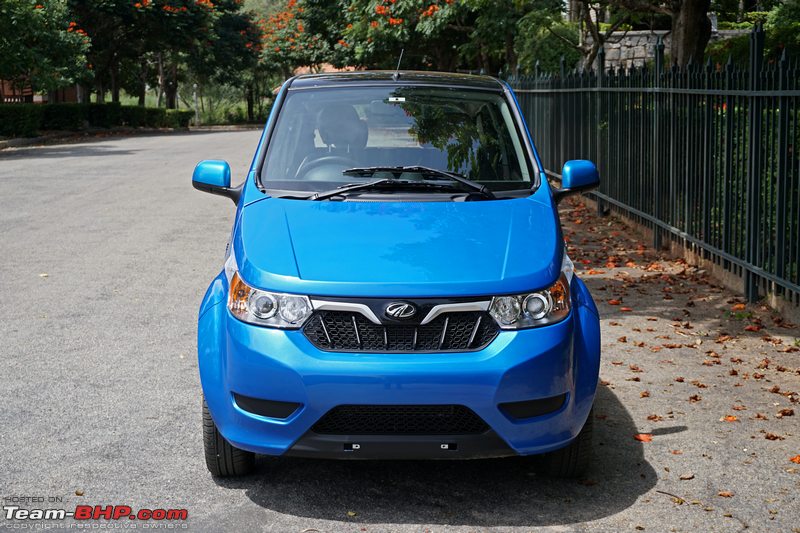 One can't deny that Mahindra makes a noticeable effort to push itself into new territory. Be it partnerships with budding tech-mobility startups, its plans to bring self-driving technology to farm equipment, or its involvement with Formula E. One such step was the acquisition of electric car company - 'Reva' in 2010. Six years down the line, the EV division has been reincarnated as Mahindra Electric. The Reva brand is no longer used. Mahindra says that when Reva was acquired, they didn't really wish to scrap the name altogether. But increasing partnerships of the Mahindra Group with other companies made it necessary for the brand to become more Mahindra-ish. In addition to that, Mahindra being a familiar name in households would help take away some of the uncertainty associated with electric cars in India. Under the Mahindra Electric umbrella, the company currently sells three cars - the e2o, the obscenely priced eVerito sedan and the eSupro commercial van. While the eVerito and eSupro are essentially electric versions of fossil-fueled models, the e2o was designed from the ground up to be an all-electric car. However, despite its purpose-driven design, the e2o flopped on launch in March 2013. Primarily, it was the exorbitant price tag that was keeping potential customers away. There were also complaints about the impracticality of the e2o only being offered as a 2-door vehicle and of course, the standard doubts about the limited range of up to 100 km per charge. 3 years later, Mahindra has incorporated some of this feedback and thus enters the 4-door e2oPlus. We'd caught this car being tested last year (link to news). The e2oPlus is essentially a stretched iteration of the original e2o, with two extra doors, some styling tweaks, larger wheels and a few updates to the battery & electric drivetrain. This certainly makes it a more 'complete car' from an Indian customer's perspective. Whether or not Electric Vehicles are the way forward is something we have already discussed in the 2-door e2o review. With the e2oPlus, the question is more about whether the 4-door structure can boost interest in a car like the e2o in this pre-nascent Indian EV market. However, with prices being the way they are (especially for cities other than Delhi), the no.1 complaint about the e2o will still be the biggest deal-breaker here.  The silver lining on Mahindra's cloud is that the e2oPlus is aimed more towards the export market than domestic customers. It needs to as sales in India are in 2-digit figures per month. Mahindra does have the capacity to ramp up production to 2,500 / month if needed - though that's still a distant dream. The e2oPlus will soon be launched in the UK, where the 2-door model has been on sale for a while. Bigger Government subsidies and a more capable infrastructure have helped the UK and other European countries to emerge as the most eager markets to accept electric mobility. Mahindra will certainly be trying to grab a bigger slice of that pie with the introduction of the 4-door version. In order to accommodate the two added doors, Mahindra has increased the e2o's overall length by a whopping 310 mm! Don't forget that, while the earlier e2o was a 2-door, it did already have a fairly usable rear bench. This increase in length has gone almost entirely towards the extension of the wheelbase (+300 mm), resulting in a massive increase in legroom (more on that later). The growth of the wheelbase also means that the car still has the short front and rear overhangs that gave it a tucked-in look. The e2oPlus is also wider by 61 mm, and taller by 25 mm. All together, these dimensional additions make a noticeable visual difference. While the two-door car looked dimensionally comical on the road (next to regular hatchbacks), the e2oPlus manages to hold its own, at least from the side view (it still looks extremely narrow head-on though). Just like the 2-door version, the e2oPlus is built on a steel tubular space frame. However, the structure has now been stretched to facilitate the two added doors. As expected, all these dimensional increments have translated into weight gains of roughly 109 kilos over the 2-door version. Mahindra claims to have kept this in check by further optimizing the weight of several components, including the usage of lighter high-strength steel for certain parts of the tubular frame. Conservative buyers will be happy that the e2oPlus has taken a step towards looking more like a regular hatchback. At the front, Mahindra designers have made the previously oversized front grille smaller, and given it the 'Mahindra family' treatment. The side view is where the changes are most apparent. The quirky profile of the 2-door model has been bid farewell to, in favour of a more mature 4-door structure. The unusual rear window that used to drop down to the taillight has been abolished entirely. The window line now drops with a sharp kink just after the B-pillar (à la Mobilio, to maximize the rear window's glass area), and ends by the time it reaches the C-pillar. This particular design element is an improvement, but still doesn't feel in sync with the rest of the car. The rear door handles are placed up where the quarter glass might normally be, just like the Chevrolet Beat. Ironically, these well-hidden rear door handles make the addition of the rear doors look like a "two steps forward, one step back" exercise. The rear is undoubtedly the cleanest and most elegant angle of the e2oPlus. The vertically-placed tail lights accentuate the car's tallboy stance. The number plate housing has been moved up to the tail gate, above which sits a black plastic panel that joins both the tail lights. The rear bumper features a simpler design, especially as compared to the incredibly tall unit found on the 2-door model. It also houses a rear camera that has been placed a bit too low (you'll see why later), and a blacked-out skidplate area as a smart touch to reduce the visual bulk. While the design elements have certainly taken a small step towards looking more like the average mass-market hatchback, the implementation is below average. The exterior fit & finish of our test car left a lot to be desired. There were huge panel gaps at the door edges, bumper and front fender; even the window beading was noticeably misaligned. We were told that our pre-production test car was painted at a 3rd party paint shop to simulate the final production colour (the production versions get body panels that are pre-coloured ABS plastic). It is possible that a lot of the fit and finish issues like the rubber beading, panel gaps and even doorpad fitting were caused because of refitting them at the third party paint shop, but Mahindra should put their best foot forward at a press event, right? The 2-door e2o certainly wasn't this bad. In fact, it was leagues ahead when it came to fit and finish. Let's see how the final production cars fare in this respect. The larger wheels and length certainly make the e2oPlus seem more planted: 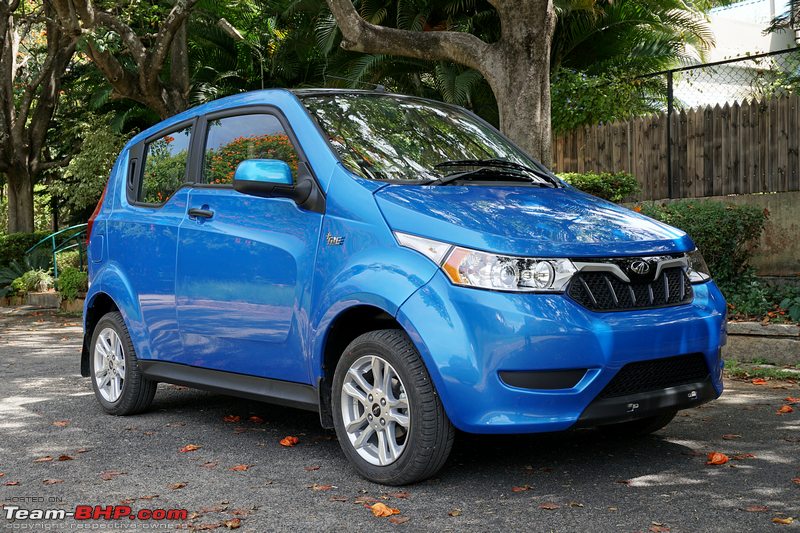 The 300 mm longer wheelbase is clearly evident. Things look very similar to the 2-door e2o up until the B-pillar, after which it's all different: 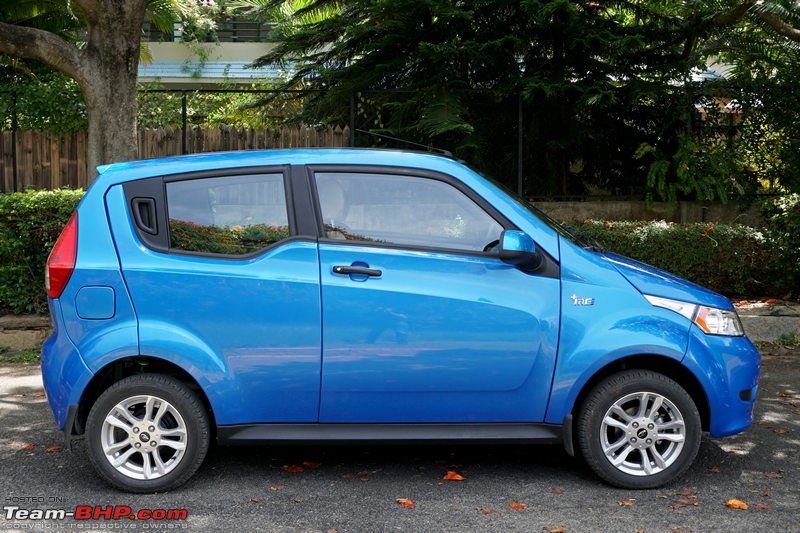 4-doors mean practicality to a country that doesn't take kindly to 2-door cars: 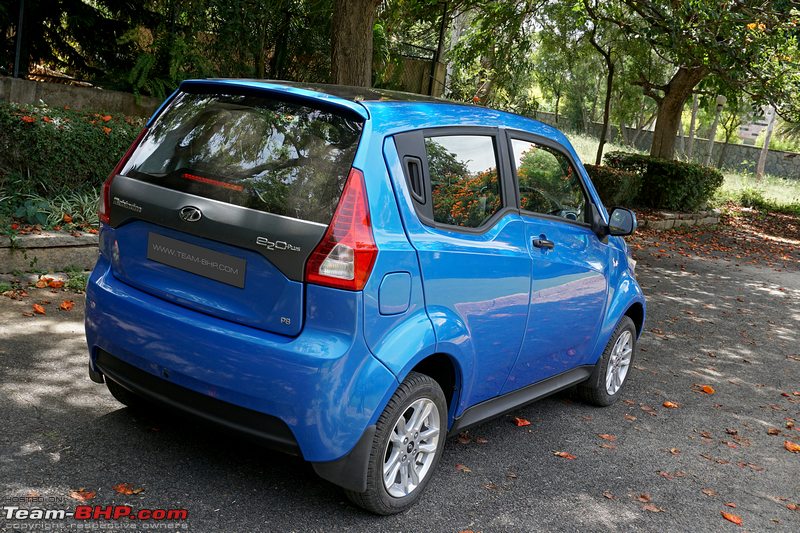 Rear styling is tight & clean. It's free of any design quirks that might divide public opinion (unlike the other angles): 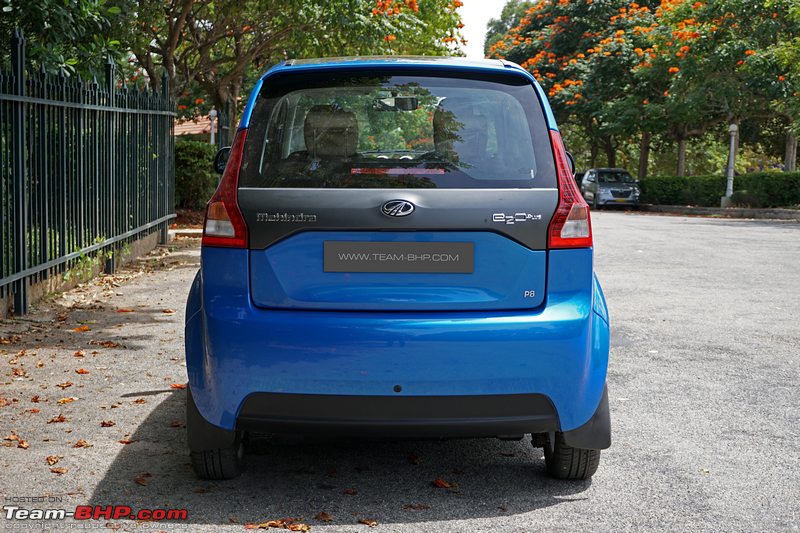 Showing off its party trick, ladies and gentlemen. All 4 doors open: 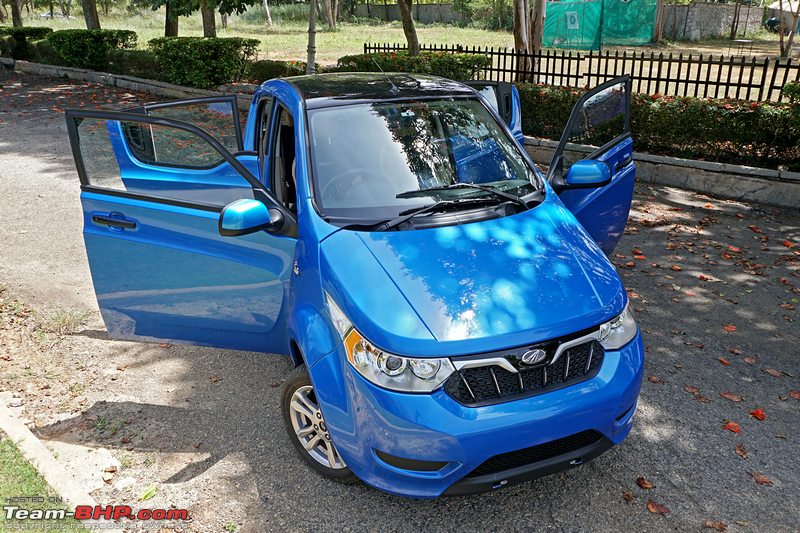 This isn't a tiny hatch anymore! Size-wise, it's playing in the same league as the B-segment, but it still manages to stand out as being different: 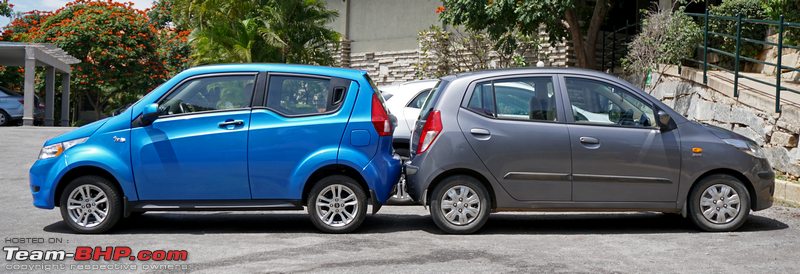 The e2oPlus still gets a sloping nose with large wraparound headlights at the corners:  The halogen projector low-beams. Main headlamp housing also contains the indicator bulb: 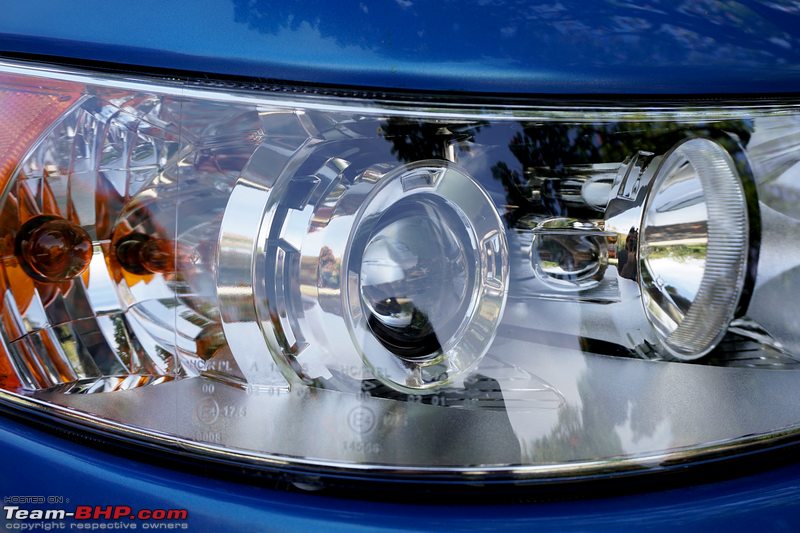 Just a little further up, another indicator housing protrudes from the body. This one does duty instead of a fender or ORVM-mounted blinker: 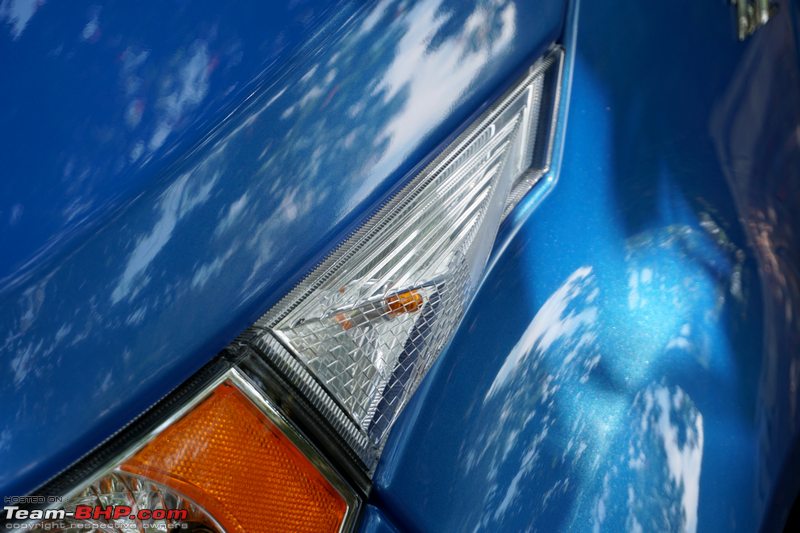 Foglamps aren't offered on the Indian version. All we get is a black filler: 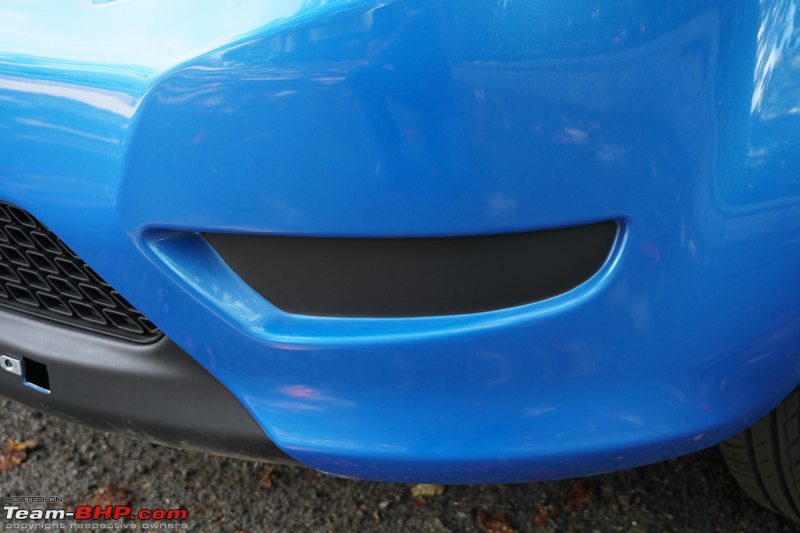 The new grille doesn't drop as low as the one on the 2-door e2o did (reference image): 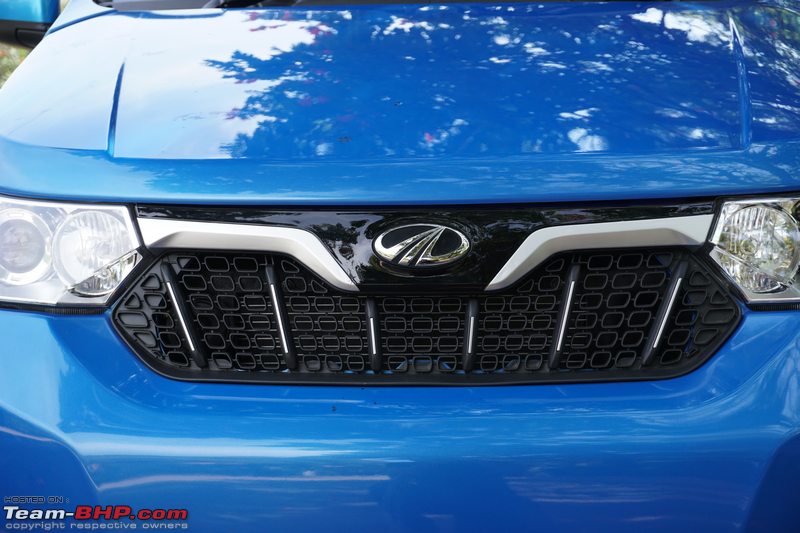 Mahindra's signature claw-like detailing, with raised black & chrome elements on the grille:  The lower half of the grille has a cool perspective effect to its pattern. The A/C condenser can be seen behind it: 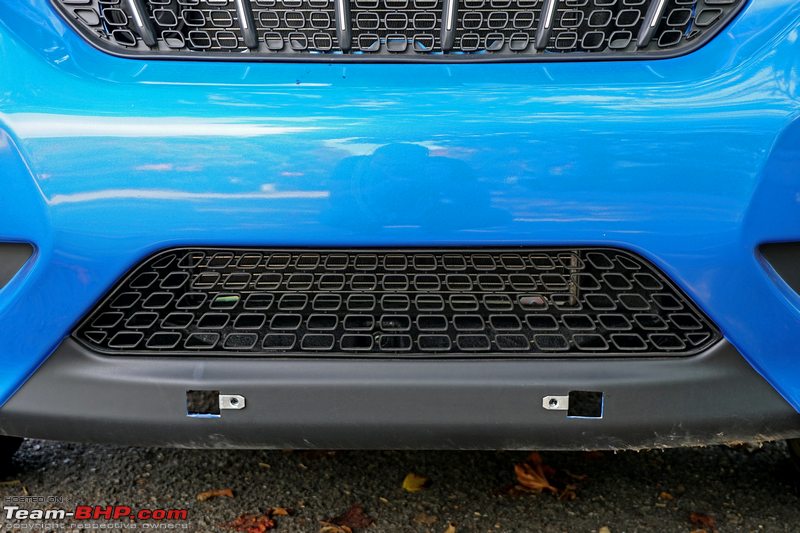 Ground clearance is 170 mm (10 mm less than the e2o). We went over a massive speed breaker and had no problems, despite the enhanced wheelbase: 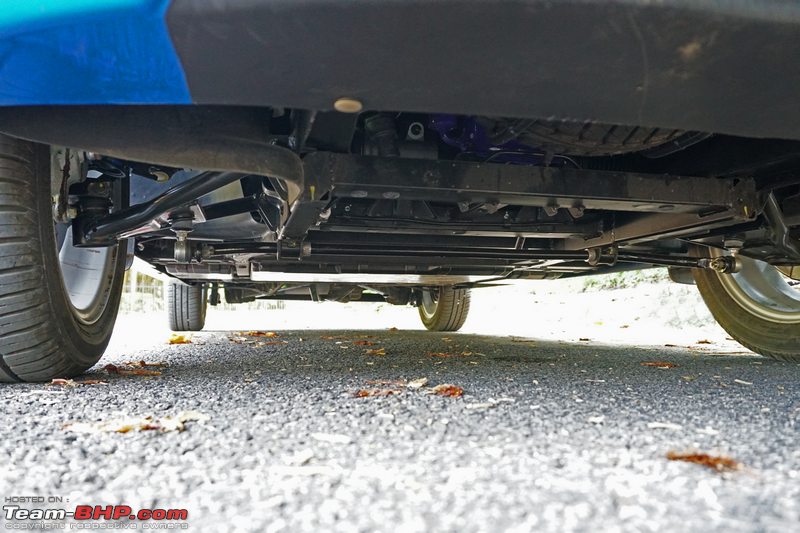 Scissor-style wipers, though they do sit rather high up even in their 'off' position: 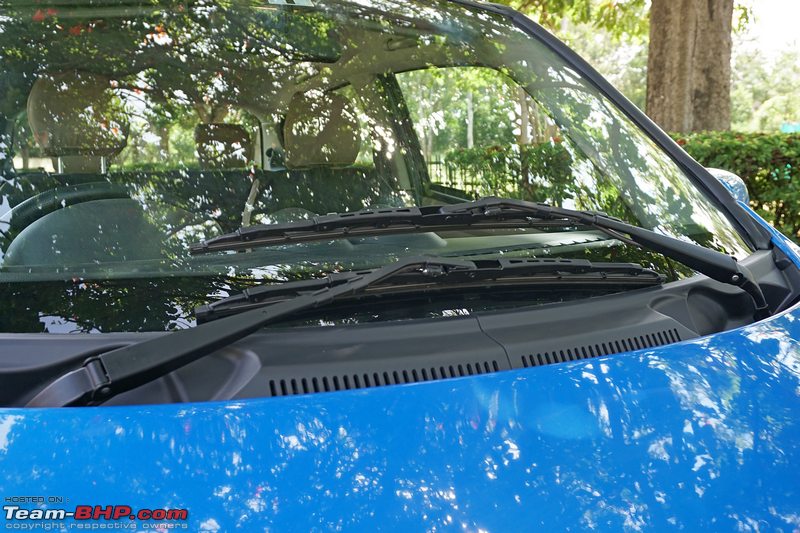 Plastic cladding covers most of the front wheel well: 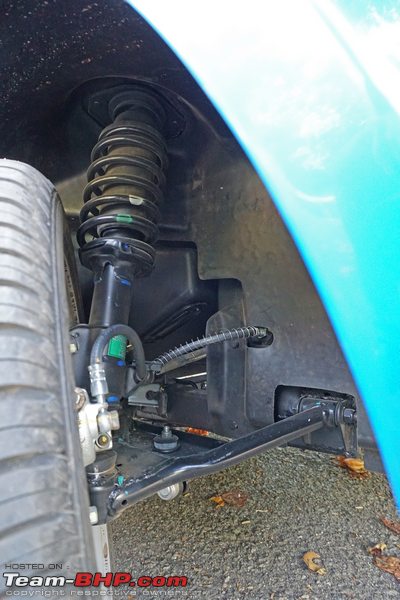 A 'Mahindra Electric' badge sits on the front fender on either side: 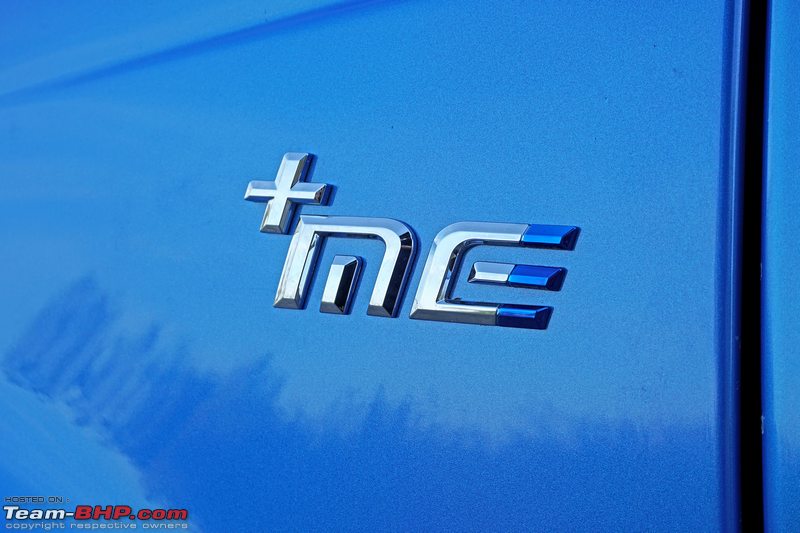 Mirrors are similar to the e2o's, but the awkwardly placed block with REVA badging (below the mounting point) has been removed:  No body-coloured door handles: 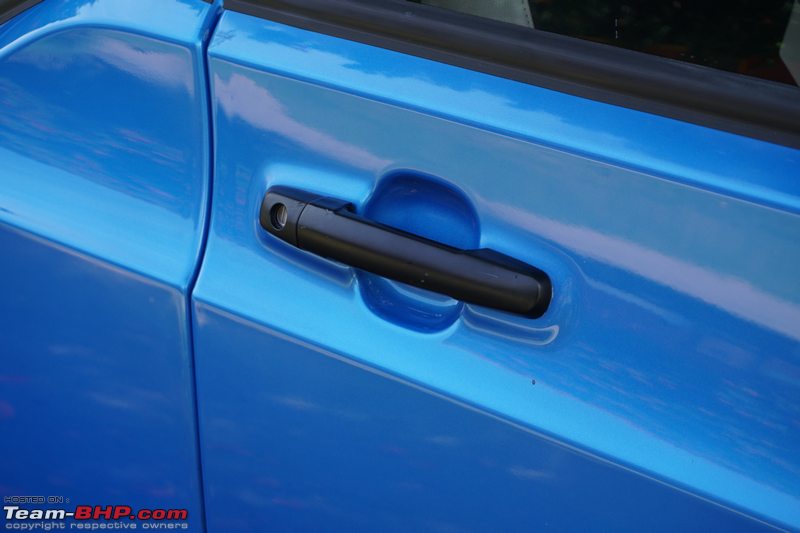 One of the few traces of 'Reva' still left on the car: 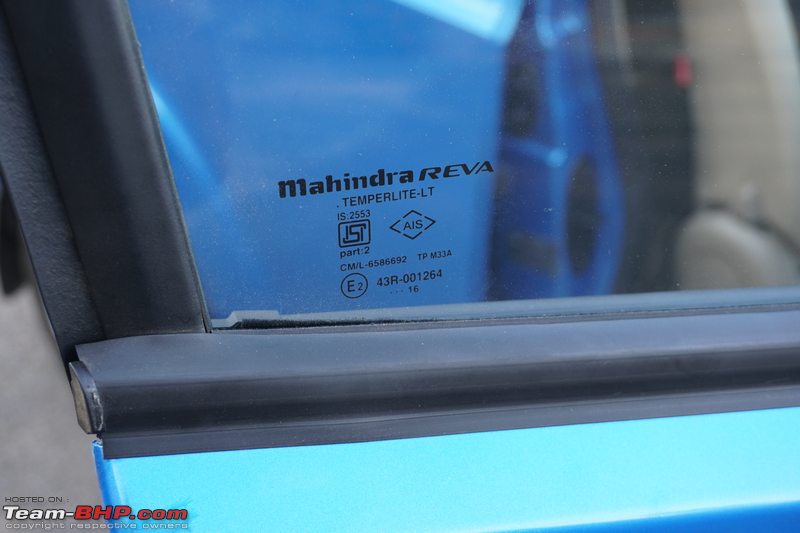 Unimpressive rubber beading quality. Looks so ugly!  Misaligned strips on the window sills: 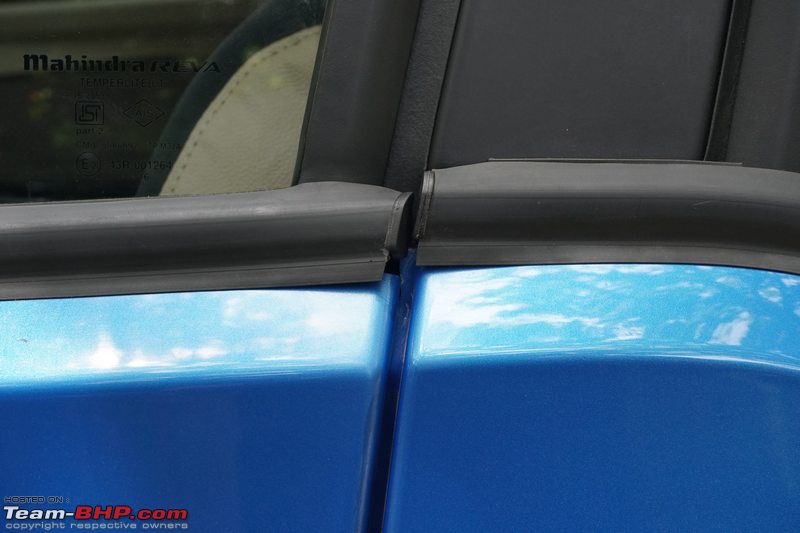 Alignment issues, even when the door is shut firmly (we might add it always took multiple attempts to get the rear doors to shut completely): 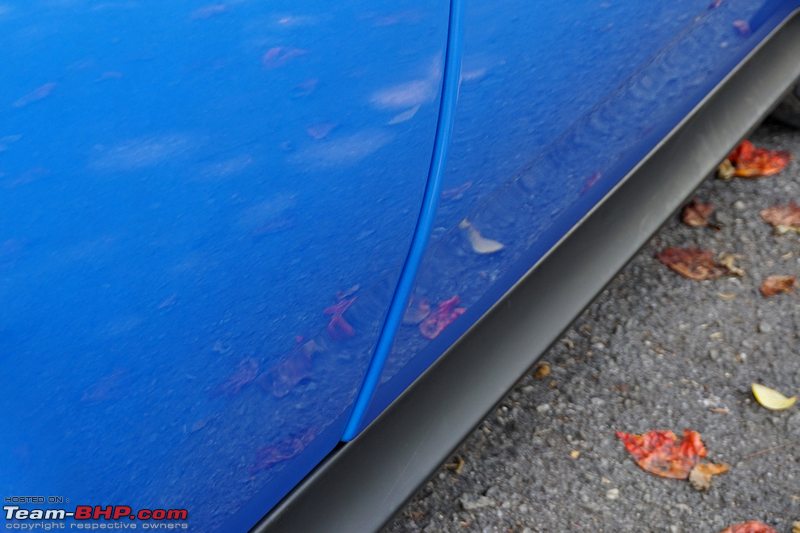 These black plastic side skirts add a nice touch to the overall look of the e2oPlus: 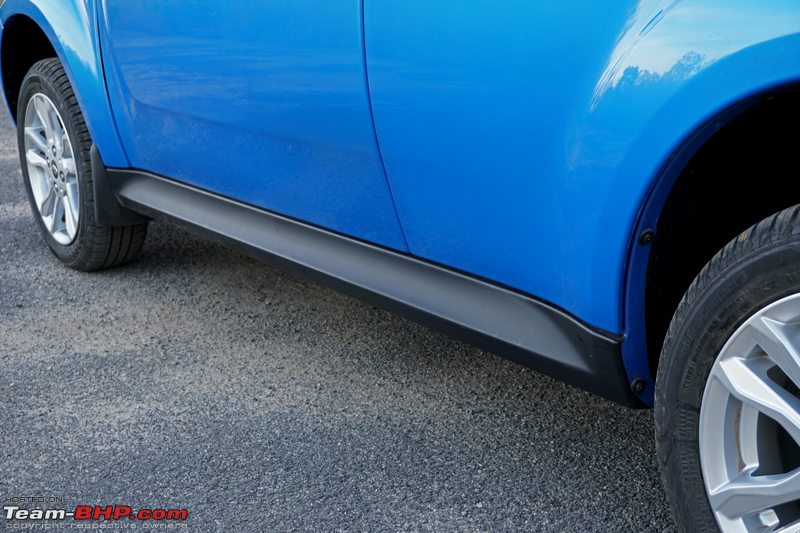 A rather long and fairly standard antenna sits at the front: 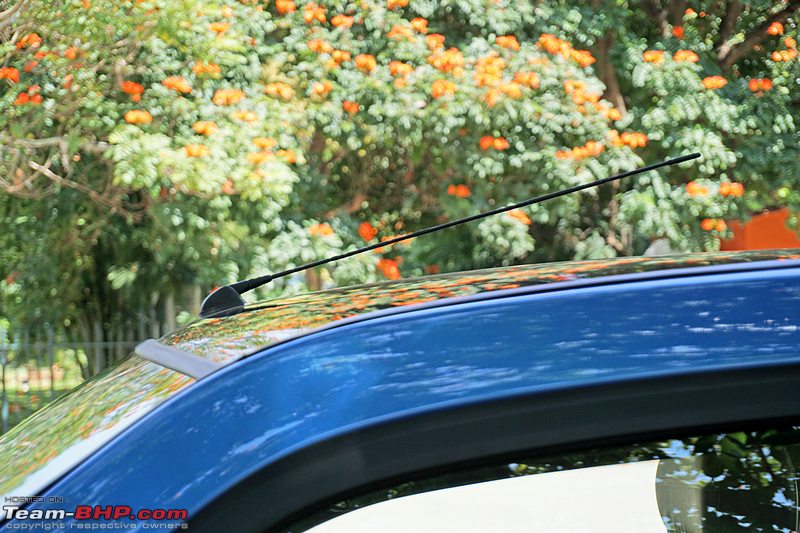 Shiny black contrast-roof is standard, and certainly makes the car look cooler. Downside? It might make the cabin hotter:  The rear window sill drops significantly to liberate more glass area for rear passengers. Not the most cohesive design touch: 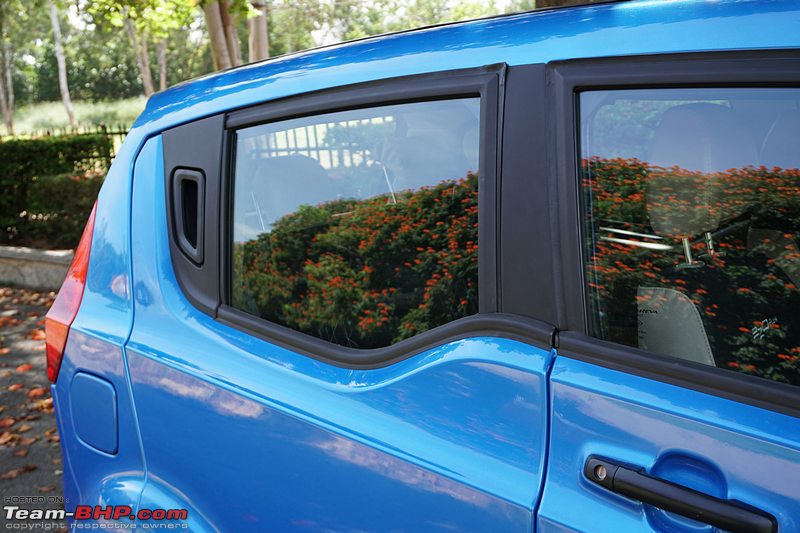 Rear door handles are mounted where the quarter glass normally sits (à la KUV100 & Chevrolet Beat):  While the handles may be hard to spot at first, they certainly are chunky and easy to use: 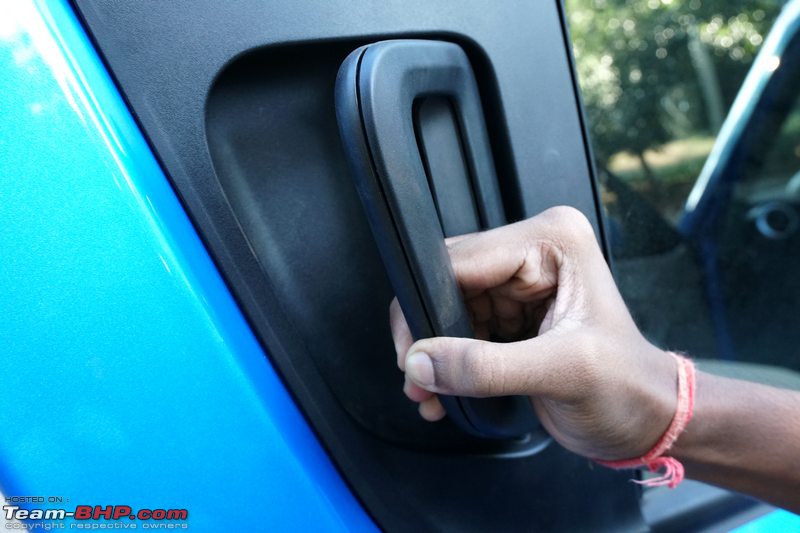 Panel gaps and shut-lines were uneven more often than not. Notice the gap at the top edge of the door vs the bottom edge:  Hardly surprising to find a charging point on an electric vehicle...however, the e2oPlus has TWO! 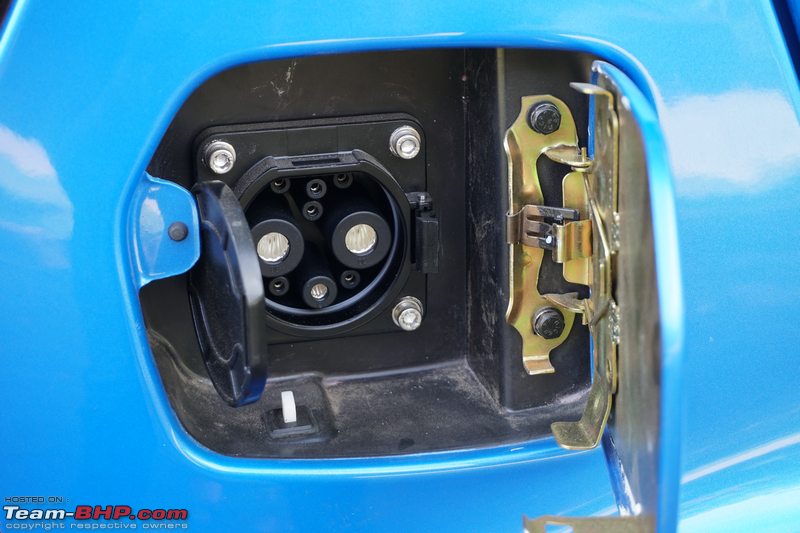 The other one is a "Type 2" charging plug, which is the common standard across the EU. It's also good to see that the charging point has moved from the boot (old e2o placement) to a more conventional fuel filler cap location: 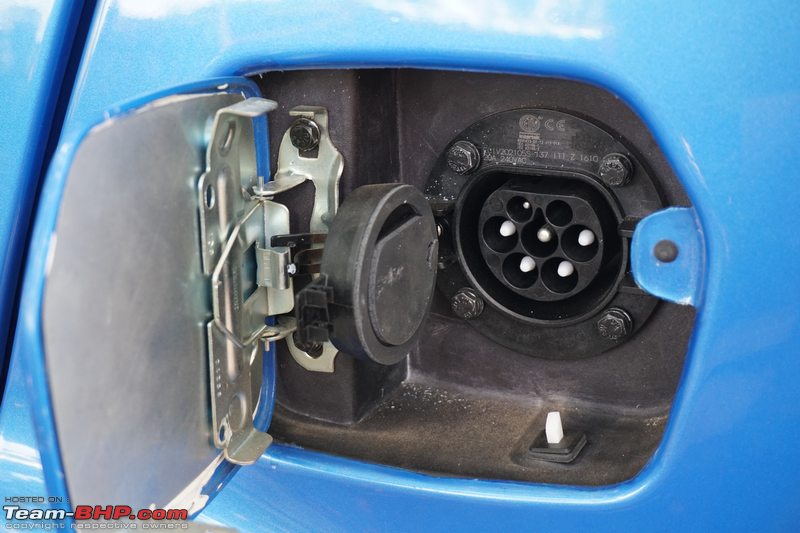 The e2oPlus gets 14" alloys (an inch larger than the e2o's 13-inchers). The upsize certainly helps the looks too. Tyre size is 165/60 R14: 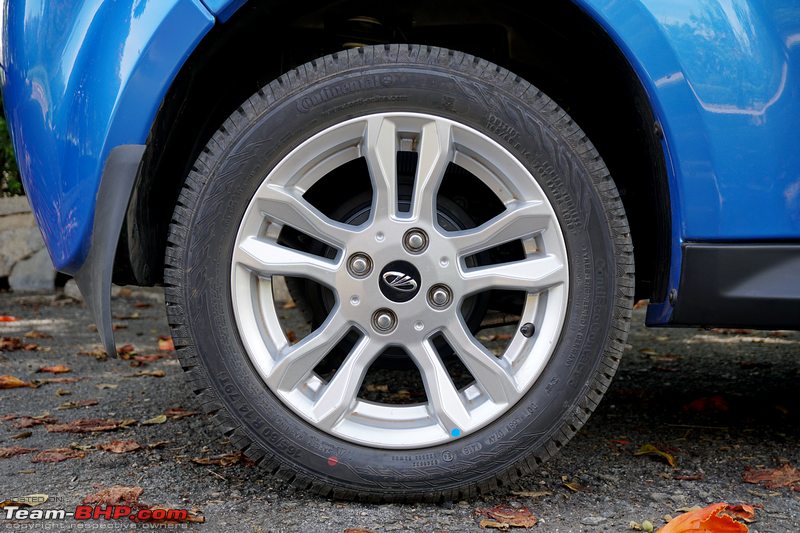 Rear wheel wells are also clad in plastic: 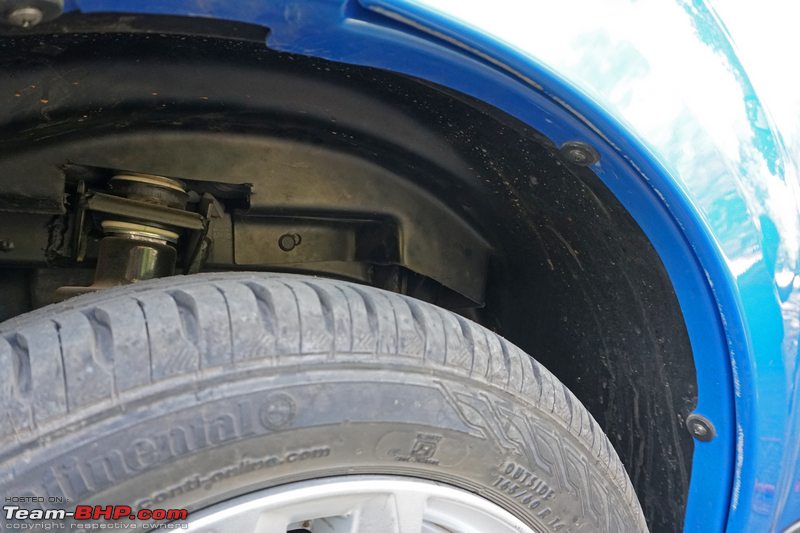 The short blocky tail lights have been replaced with more contemporary looking pieces:  Integrated rear spoiler is certainly not for aerodynamics (e2oPlus top speed = 85 km/h)! 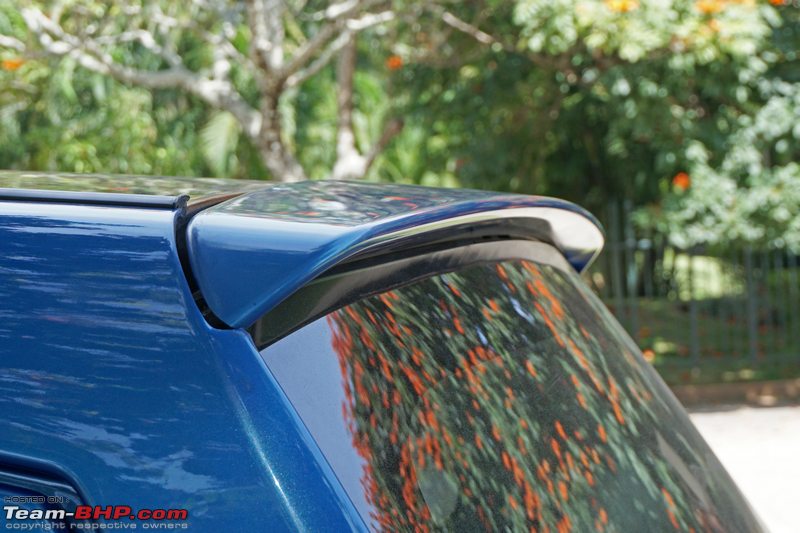 A wide center-mounted stop lamp sits at the bottom of the rear windscreen: 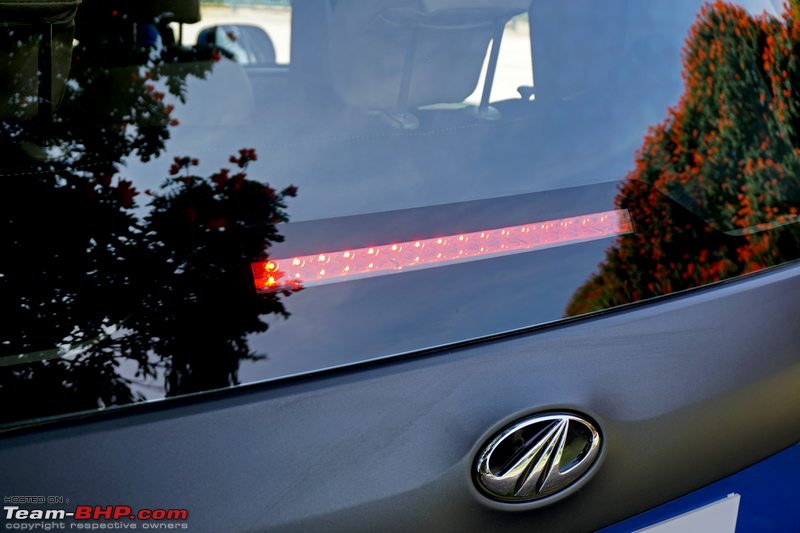 e2oPlus badging at the rear - check out how the "P" has an integrated "+" sign: 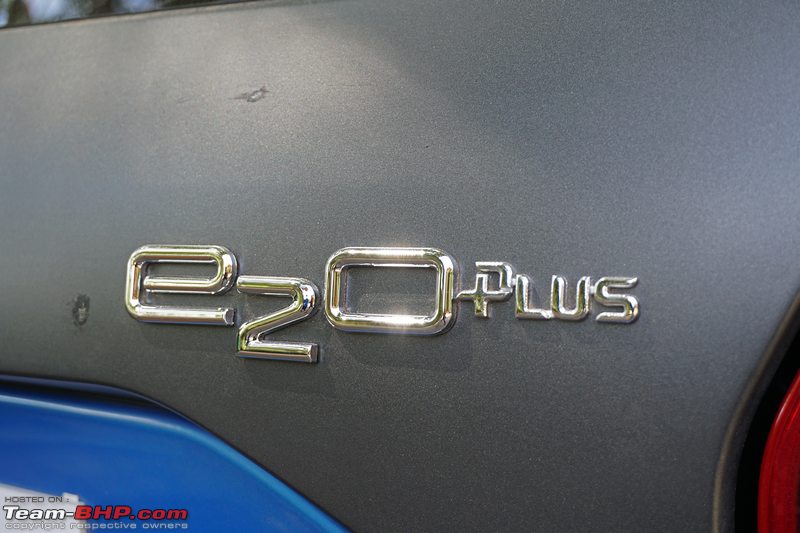 The P8 is the top-end variant (and the only one to get the 72 volt battery). The other variants being the P2, P4 and P6 - all of which get the 48 volt battery:  Rear bumper gets a very low mounted reverse camera, and a blacked-out skidplate area that looks excellent:  Mudflaps are well integrated: 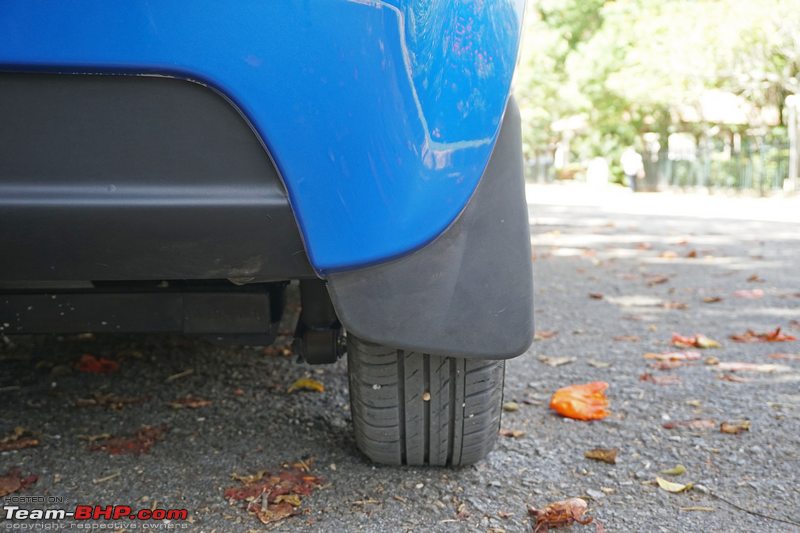 Last edited by Rehaan : 13th December 2016 at 15:43. |
| |  (18)
Thanks (18)
Thanks
 |
| The following 18 BHPians Thank Rehaan for this useful post: | CarguyNish, chinmaypillay, drrajasaravanan, GTO, Guna, hemanth.anand, Karthik Chandra, LoneRidder, MSAneesh, Obi-Wan, Rajeevraj, RavenAvi, roy_libran, RSR, S2!!!, samabhi, SmartCat, V.Narayan |
| | #4 |
| Team-BHP Support  Join Date: Feb 2004 Location: Bombay
Posts: 24,042
Thanked: 34,074 Times
| Re: Mahindra e2o Plus : Official Review Interior - Front At the front of the cabin, the e2oPlus' interiors are laid out identically to the 2-door e2o. However, there have been a handful of cosmetic updates; namely, a few areas of black plastics have been replaced with beige plastic instead, the upholstery gets a new pattern, the piano-black wood design trims have been replaced with what looks more like a shiny black carbon-fibre pattern, and the earlier head-unit has been replaced with an Android head-unit from Blaupunkt. A familiar place for those used to the e2o. Plastics used are of satisfactory quality:  The steering wheel is adequately sized, although it lacks an overall feel-good factor. There aren't any steering-mounted audio controls, which allows the hornpad to stretch all the way to the rim:  The hornpad has rough edges and somewhat reminds you of the quality found in an Alto. The fixed steering still doesn't get reach or height adjustment. This causes an issue for taller drivers where the top of the wheel obstructs the view of the instrument cluster, which was an issue in the 2-door model as well:  Fully digital, blue lit instrument cluster is exactly the same unit as in the 2-door model. Parameters shown include distance to empty (DTE), Status of Charge (SOC), Odometer, Speedometer and a digital rpm gauge (being a single-speed transmission, this is equivalent to a speed gauge). The cluster also shows which 'gear' you're in (Reverse, Neutral, Forward or Boost), and what the efficiency of your driving is, including when regenerative braking (E-gen) is occurring. The 'REVA' branding can be spotted here as well:  Indicator and wiper stalks are a straight lift from the 2-door model. They seem pretty solid:  Gaping uncovered holes at the base of the stalks are an eyesore!  Circular A/C vents are detailed with a silver plastic ring on the outside. The A/C is sufficiently powerful to cool the cabin on a moderate day, though the blower noise is on the higher side once you go beyond the first 2 levels (of 6). The compressor size has remained unchanged, despite the increase in cabin volume. The vents can be rotated in any direction, and even be shut completely:  Switchgear to level the headlights and operate the electrically adjustable ORVMs was flimsy and felt cheap. On the plus side, they are backlit. On the left is the lever to pop the hood. There's a small storage spot just behind it: 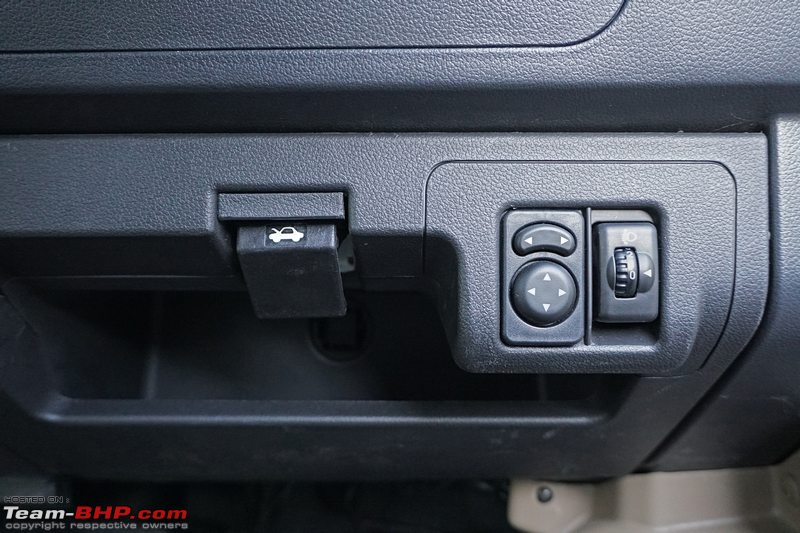 The 4-door model gets beige treatment on the doorpads, instead of dark grey on the regular e2o. The plastic doorpads are styled nicely. They get a fabric insert in the middle and a contrasting black trim for the armrest:  Our test car had an awful fit on both the front doors. The entire plastic pad shook a little each time the door was shut. The inside door handle required a hard pull in order to open the door. The lock had no tactile feedback whatsoever (i.e. it didn't click into place). You could only tell if the lock had been activated/deactivated by the sound of the mechanism. The beige plastic cladding didn't even meet the black plastic inset firmly, leaving the sharp plastic edge exposed. Overall, it felt terribly fitted:  The loose rubber beading between the window glass and doorpad was one thing. This H-U-G-E gap between the glass and doorpad was another!! I could shove half my hand in the gap! Note: The glass is rolled up in this picture:  Front doors house a 1-litre bottle holder along with an elastic string to prevent stored items from moving around:  Front seats are similar to the ones offered in the 2-door model. The cushioning is a bit on the firmer side, which is something we prefer. The seats offer adequate back and lumbar support. The adjustable headrests too are of the right size. However, since the seats are very narrow, heavier folk won't be as happy with them. Note that our test car was adorned with seat covers. We've included a picture of the actual upholstery at the end of this post:  The tallboy-like high seating position enables the batteries to be housed under the driver & passenger seats. The 2 brown levers shown are leftover from the fold-and-slide mechanism used for rear seat access in the 2-door version. Yes, they do function the same way even on the 4-door  : : A combination of the high seatbase and fairly thick A-pillar meant Bhavik (5'7" - pictured here) and I (5'8") both hit our heads a couple of times when getting into the e2oPlus. Once you are in, the taller seat height provides a nice and commanding view of the road ahead. As for seated headroom, when I was sitting up extremely straight, there was just 2-3 inches of additional headroom available. It's also worth noting that because of the extremely long front window (a remnant of the 2-door design), the B-pillar is further back, making the twist to grab the seatbelt buckle more of a reach than usual. Nope, the seatbelts aren’t height adjustable:  The bar used to adjust the seat's fore/aft position protrudes out a bit too much, and tends to hit the back of the driver's calves at times:  The wheel-well does eat into the footwell significantly. This results in the accelerator pedal being placed a lot further towards the left. It is located closer to where the brake pedal might be in a normal car, so you need to be a little careful at first. Notice the huge dead pedal too - good to have in an automatic. Don't miss the front speaker placement here:  Our test car was equipped with these e2oPlus mats (normally an accessory) which were very nice. It has a rubberized heel-rest in the center:  2 levers to open the charging port flaps. We can assume the one with the double triangles is the fast-charge port:  The ORVMs are tall enough, but should have been a size wider:  Rear visibility is better than the 2-door e2o, thanks to the rear glass being a lot taller here. The IRVM is wide enough to span the entire rear windshield and more. When parking, the reverse camera can help fill in the gaps:  The C-Pillars are thick though, and the blind spots in the rear corners are made bigger due to the window-mounted rear door handles. This can be an issue when reversing, so take care: 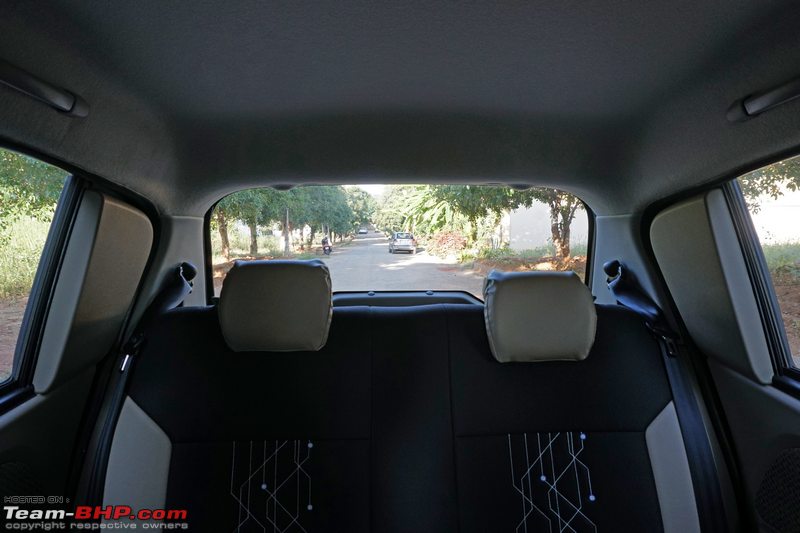 The center console gets what can best be described as a carbon-fibre-like pattern, instead of the black faux wood found on the 2-door variant (image link). The touchscreen infotainment system of the e2o has been replaced with an Android headunit from Blaupunkt (more on that later):  Below the head-unit are the A/C controls, which are the same as the ones found on the 2-door model. The knobs are of satisfactory quality and operate with adequate feedback. The selected positions light up, and are visible in the daytime too. Check out how the boot release button has been sneakily positioned here (2 o'clock on the biggest circle):  Interestingly, on the e2oPlus, the console between the front seats is beige in colour (it was dark grey on the 2-door model). Aux & USB ports, as well as a 12V power socket, are located in a cubby hole ahead of the gear lever:  Markings on the gear lever look like they were part of a school kid's project! The shifter emulates traditional automatic transmissions, probably to keep the sense of familiarity. There is a button at the front of the knob that needs to be pressed when switching between Reverse-Neutral-Forward:  Power-window switches are placed in their least favourite place; behind the gear lever. Interestingly, the e2oPlus is now a 4-door car with all doors getting power windows, but only the front two windows can be controlled from the driver's seat. There is no auto up/down functionality on any window. The entire center console is placed slightly towards the driver, which means the driver's side window switch gets hidden by the edge of the seat (from the driver's viewpoint):  A cubby hole is provided behind the handbrake. It can be used by rear passengers as well, as they don't get any bottle holders on the doors:  The glovebox is average in terms of width, but not very deep (5.5-inch OnePlus One kept for reference). Overall quality is rudimentary. The lever needs to be pulled hard to open the glovebox, and due to some misalignment and flexing in the lid, it wasn't too keen to shut. It does however open in a smooth damped fashion:  Driver-side sunvisor sports a ticket holder, while the passenger's side gets a vanity mirror:  The single cabin light is placed towards the front. Since the e2oPlus is a 4-door car, it would have been preferred if they relocated the cabin light towards the center of the cabin for the benefit of all passengers:  Keyfob has the usual lock and unlock buttons, along with a remote boot release button. On the backside, there is some text and an arrow indicating which way to touch the keyfob to the start button, in order to authenticate the key. We had a lot of issues with this being fidgety in the 2-door version, but using this tip helped make key-authentication work flawlessly on the e2oPlus:  Our test car came with seat covers. This is the original seat upholstery. The fabric pattern is similar to the one on the doorpads:  Last edited by Rehaan : 21st October 2016 at 14:25. |
| |  (18)
Thanks (18)
Thanks
 |
| The following 18 BHPians Thank Rehaan for this useful post: | CarguyNish, drrajasaravanan, GTO, hemanth.anand, Karthik Chandra, LoneRidder, MSAneesh, Obi-Wan, Rajeevraj, RavenAvi, RSR, samabhi, SmartCat, sourabhzen, The Rationalist, theexperthand, V.Narayan, Vitalstatistiks |
| | #5 |
| Team-BHP Support  Join Date: Feb 2004 Location: Bombay
Posts: 24,042
Thanked: 34,074 Times
| Re: Mahindra e2o Plus : Official Review Interior - Rear For rear passengers, Mahindra has done one better than just enabling easier ingress + egress with the addition of 2 doors. They've greatly increased the legroom by a huge amount, made the window area a lot larger and enabled easier loading/unloading to the larger boot. With the addition of rear doors, there's no more crouching your way into the rear seats of the e2o. However, it's still a bit of a squeeze due to the B-pillar being set rather far back. The door funnels you into a tight gap. Traversing the wide wheel arch to reach the edge of the seat is also something that makes getting in and out of the rear seat less than perfect:  All doors open in a two-stage manner. The door itself is light, yet the mechanism feels hefty. The rear doors are smaller in size as compared to the front doors. No bottle holders or door pockets here:  While the housing for the door handles looks like a big intrusion into the window area, it's actually not a bother at all. The enclosure is positioned so far back that when you're seated, it's barely in your peripheral vision:  Handle area gets the same glossy black carbon-fibre sort of finish that is found on the centre console. Fabric insert given too. The rear speakers are housed on the lower part of the doorpad. And Halleluiah! - window switches positioned on the doorpads!  Due to the angle & width of the B-pillar, and the shape of the front door, there's a big vertical black eyesore when you view the opened rear doors from inside:  The rear bench is fairly high-perched. Aside from the narrow entry-way, it's at a convenient height to get into for older folk. Rear passengers will get a nice view up front, thanks to their tall seating position and smaller front headrests blocking less of the view:  Owing to the narrow width of the car, the e2oPlus is strictly a 4-seater. There is no chance that three large adults can be accommodated on the rear bench. Interestingly, even Mahindra acknowledges this, as the official spec sheet mentions the seating capacity as 4. The seatback is raked at a comfortable angle and the cushioning is the perfect shade of firm. Underthigh support is good for the average sized passenger:  These adjustable headrests greatly compliment rear seat comfort. Unlike most cars which give the rear headrests just two height settings (Danny DeVito or Shaquille O'Neal), the e2oPlus' headrests have 4 lockable positions in its range. This makes finding the optimum position for your height very easy:  The sheer amount of leg space on offer is bound to impress many. Even with the front seat pushed all the way back (yes, the front passenger seat is pushed all the way back in this picture), the legroom is still aplenty. Bhavik here (5'7") said that even in this position, the legroom was better than his Maruti Dzire. Though knee room is plenty, we can't say the same about headroom. Despite the e2oPlus being a tallboy, the higher seating position means that anyone above 5'10" will suffer from limited headroom:  And here's what it looks like behind the seating position of a 5'8" front occupant. Superb legroom!  The only fly in the legroom ointment is that, if you want to extend your feet forward under the seat ahead, you can't. The housing for the battery pack comes in the way. This might be more of an issue for taller passengers with longer legs. Since we're here, let me point out the seatback pockets and central cup holder:  It's surprising to see a prominent floor hump on an electric car, since there isn't any transmission component that needs to be routed through the hump, and the space-frame construction means monocoque strengthening probably isn't the reason either. Perhaps, it's the safest route for the wiring between the batteries at the front and the motor at the rear. Either way, it doesn’t interfere with the feet of rear seat occupants, especially since there is no room for a middle passenger anyways!  The rear window area is large enough to bring sufficient light into the cabin. The sharp kink on the window line drops pretty low, so as a passenger, you can see much further down than you normally would in any other car. This is the max level that the window rolls down to: 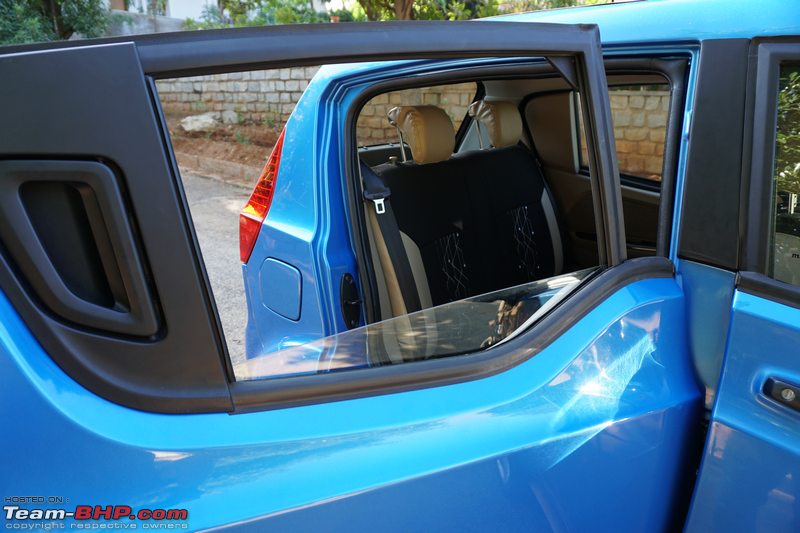 On paper, at 135 liters, the boot space is too meagre to be compared to other hatchbacks. This is because the boot floor is comparatively higher (the motor & controller are below it). In practice however, it's an extremely usable boot. I mean, it's not like you're going to be packing for long weekend trips in the electric e2oPlus anyway! Compared to the e2o, the Plus gets a much lower loading lip and a wider mouth too. This makes the available space easier to access:  Here's a well-stuffed backpack for scale. Also note the storage pouch integrated into the back of the seat:  The seatback can be flipped forward to liberate more space. Just lift these painfully difficult knobs and push it forward:  Several finger-numbing moments later....here's the space with the seats down:  Last edited by Rehaan : 21st October 2016 at 14:33. |
| |  (17)
Thanks (17)
Thanks
 |
| The following 17 BHPians Thank Rehaan for this useful post: | ashishk29, CarguyNish, frankmehta, GTO, hemanth.anand, Karthik Chandra, MSAneesh, Obi-Wan, Rajeevraj, RavenAvi, roy_libran, RSR, samabhi, SmartCat, theexperthand, uday.ere, V.Narayan |
| | #6 |
| Team-BHP Support  Join Date: Feb 2004 Location: Bombay
Posts: 24,042
Thanked: 34,074 Times
| Re: Mahindra e2o Plus : Official Review In-Car Entertainment The 2-door e2o had a fairly feature laden head-unit. The e2oPlus continues that trend, with a new Android HU from Blaupunkt. It supports the usual host of Bluetooth, USB, Aux and micro-SD inputs. Over & above, the ICE has navigation, Wi-Fi and a few special e2o-specific features like checking the level of charge, initiating 'revive', reading the car's manual etc. The head-unit has an infrared port, but there was no sign of an infrared remote control in our test car. The home screen looks like a cross between an Android and Windows Phone. The top row of icons can be swiped left or right. It's a resistive touchscreen, so at times, it scrolls nicely but at other times, it either doesn't register the swipe or mistakes it as a click. Takes a little getting used to. At the top corners, there are 4 hardware buttons for Home, Navigation, Menu & Back:  This image shows the audio/video sources available. I had a 720p mp4 movie on my thumb-drive and the system played that on its crisp and high-resolution screen without a hitch. Even fast forwarding through the video wasn't a problem. Pressing the volume knob inward simply mutes the audio. You need to long-press it for power on / off:  There are 2 micro-SD card slots. One is for the map data, while the other can be used for your media files:  The interface is functional, though it still doesn't look particularly contemporary. The screen is very sharp, and visible in most conditions. However, in extremely bright top-down sunlight, the sun hits the screen directly, causing a lot of glare:  There's an 8-band equalizer. Strangely, you can't adjust the lower frequencies unless "Bass" is selected at the top, and adjusting the higher frequencies needs "Treble" to be selected. No matter what adjustments we tried, we found the sound quality to be underwhelming. The bass just doesn't exist. It doesn't have any punch, body or depth at all. Not like the amp lacks power or the highs aren't clear, it's just that the low end of the sound spectrum is inexistent. The front speakers are placed at the same position as the 2-door e2o (in the footwells, angled towards the center). This speaker placement causes vibrations on the passenger footboard as well as the driver pedals:  The rear view camera video feed was vibrating up and down constantly - even when the car was at a standstill. The guidelines shown on the reverse camera feed are fixed (they don't turn with the steering wheel):  Due to the low mounting position of the reverse camera (on the bumper), when you are backing up very close to a car behind, your field of view starts going under that car - making it hard to gauge how close you actually are. This is more the case when there's a taller car like an SUV behind you. Pictured here is an i10:  Here's what the Android "apps drawer" looks like:  No mention of which Android version is being run, and we didn't have the time to snoop around further. Guessing it's Android 4.x or earlier:  The "My Car" section contains apps specific to the e2oPlus:  Car Status shows your current battery level and estimated range:  The Revive function is a feature that can be used when you run out of charge, but need to still drive a little further. Clicking it unlocks another 5 km of range on the P2, P4 & P6 variants, and 10 km on the P8 variant:  The entertainment system has an audio-video user manual, with instructional videos for topics like "How to use revive" etc.:  Here's a sample of what the animated instructional videos look like. Very cool:  Just like the 2-door, the e2oPlus also supports telematics and the control of some of the car's features via a mobile app. While we did not get to try the app, these screenshots showing some of the functions available were shared by Mahindra:  Last edited by Rehaan : 21st October 2016 at 17:38. |
| |  (11)
Thanks (11)
Thanks
 |
| The following 11 BHPians Thank Rehaan for this useful post: | anilntny, drrajasaravanan, GTO, Obi-Wan, Rajeevraj, RavenAvi, RSR, samabhi, SmartCat, theexperthand, vinaydas |
| | #7 |
| Team-BHP Support  Join Date: Feb 2004 Location: Bombay
Posts: 24,042
Thanked: 34,074 Times
| Re: Mahindra e2o Plus : Official Review Driving the Electric e2oPlus The bay remains virtually unchanged. There's a new motor on the P8 variant, but it's at the back:  Press the 'engine start' button once and the car gets accessory power. The instrument cluster lights up, as do all the buttons and knobs on the centre console. The blue instrument cluster screen displays an 'authenticate' message just below the REVA branding. In order to start the electric motor (i.e. engine), one needs to hold the key fob at the start button for a second. In the two-door e2o, this procedure was extremely irritating as the key got acknowledged once in three attempts. However, in the e2oPlus, we were shown that the key fob has an arrow that points towards the exact side (of the fob) that needs to touch the start button. This made a huge difference, and we didn't experience any misses in the key acknowledgement procedure. Once the key gets acknowledged, the instrument cluster displays a 'welcome' message. I really wish there was some sort of an audio feedback to confirm that the key has been authenticated, rather than just a change in the display message. There is also a slight delay of a second or two between the key getting acknowledged and the screen showing the 'welcome' message. As a result, I often found myself tapping the key fob on the start button, even after the key had already been authenticated. The Mahindra e2oPlus is offered in four variants - P2, P4, P6 and P8. The first three trims come with a battery pack that delivers 110 km of range, while the top-end P8 variant can cover a distance of 140 km on a single charge. Both battery packs are rated at 210 Ah (ampere-hour). The difference lies in the number of cells in the pack, and the overall voltage. The smaller battery houses 48 cells and puts out 48 volts, while the larger one gets 69 cells and puts out 72 volts. Both these batteries feature revised chemistry of Lithium Iron Phosphate (LFP). Folks at Mahindra Electric claim this is the most stable of Lithium Ion battery chemistries currently being used in automobiles, and can survive a very wide range of operating & charging temperatures. The smaller battery found on the lower trims requires 6 hours to charge with the 16 Amp charger (single phase), while the 32 Amp (3-phase) Fast Charger can top up the pack to 95% in just 75 minutes. Similarly, the larger battery pack of the P8 variant requires 9 hours to charge with the 16 Amp charger, and 90 minutes to reach the 95% mark with the 32 Amp Fast Charger. The P2, P4 and P6 variants use the same electric motor that does duty in the two-door model. In the e2oPlus, this motor develops an output of 19 kW, which translates to 25.5 BHP; exactly the same as the two-door model. However, the torque output on the e2oPlus has increased to 70 Nm, instead of the 53 Nm figure of the 2-door e2o. We drove the top-of-the-line P8 variant which is equipped with a more powerful motor developing 30 kW (equivalent to 40 BHP). But the icing on the cake is its torque rating - 91 Nm. All this torque is available right from the moment you press the accelerator, thanks to the electric motor's flat torque curve. Translating this into common language, the e2oPlus would be a great car to attack those small gaps in stop-go city traffic. Before proceeding any further in this review, we should mention that we were only allowed to drive the e2oPlus within the confines of a large resort. This allowed us to piece together a decent picture of the driving experience, but it's still not a substitute for driving in real traffic. Why did Mahindra do this? Well, the car hasn't ever been seen undisguised in public at the time we drove it, and who knows, maybe Mahindra had range anxiety  . .Floor the accelerator and the e2oPlus pulls effortlessly up to around 60 km/h with a noticeable high pitched electric hum. The acceleration is extremely smooth and jerk free. Moreover, at speeds of around 50 km/h, there is no nervousness in the car's character. We could not test the car above 60 km/h for a sufficient amount of time, owing to the confines of the space we were driving in. The company claims that the e2oPlus P8 trim can accelerate from 0-60 km/h in 9.5 seconds. As for the more conventional benchmark of 0-100 km/h, there is no data, as the e2oPlus maxes out at a fairly limited top speed of 85 km/h. Mahindra has also added a creep function with the e2oPlus, which works in forward as well as reverse. This goes a long way in enhancing the car's stellar abilities in crawling stop-and-go traffic. Starting from a standstill is no pain whatsoever. Just lift your foot off the brake pedal and the car starts to gradually creep forward. When creeping, the e2oPlus won't cross 4 km/h - which is a medium walking pace. The creep function even works when starting from a mild gradient. Interestingly, with the creep function working on a hill, press the brake pedal (even lightly) and the car disengages the motor; as a result, the car tends to roll backwards due to the gradient. You have to press the brake pedal far enough that the brakes are making sufficient mechanical contact to stop the rolling. This comes naturally to drivers, but it's still a bit of a strange feeling. There is a Boost mode on offer as well, designed to tackle overtaking maneuvers, steep inclines and sudden dashes. To engage it, you just need to slot the gear lever one position further down, from (F)orward to (B)oost. There is a noticeable difference in power available on tap in boost mode and a greater sense of urgency in the acceleration. In fact, the full torque output of the e2oPlus is experienced only once the car is put into Boost mode. Accelerating from a standstill with the foot completely down on the accelerator, if you engage Boost, it feels like a 20% increase in the power available. Must mention, the transition from Forward to Boost is very smooth...an uninformed passenger won't really feel any jerk. Similar to the 2-door model, there is a mild electric whine coming from the e2oPlus, which becomes significantly audible while accelerating (it's audible on the outside too). Lift your foot off the throttle and the whine gets softer - but it doesn't disappear. In addition to the general whine of the motor, a spirited driving session of about 10 minutes switches on a cooling fan below the rear seat that is fairly audible (even from the front seats). It is the loudest noise you will hear from the car, and does cause a slight vibration on the left side of the rear bench. Keep in mind that the car isn't dead silent even at a standstill. There are multiple whirring and whining sounds coming from the dashboard as well as the rear at regular intervals. Fans keep switching on and off, while a metal clicking sound is heard every time you stop the car after a drive. During idling, a fan placed somewhere in the dashboard comes on after every 20 seconds, stays on for around 5 seconds, and then repeats the cycle. All these sounds make the electric experience less silent than you'd imagine. However, it's worth noting that these noises were accentuated since we were driving in closed, isolated surroundings away from city sounds. Plus the fact that there's no internal combustion engine noise to drown out the smaller sounds. Interestingly, road and wind noise are a non-issue - though that could also be due to the vehicle's limited top speed. Ride & Handling The e2oPlus gets an electrically assisted steering wheel (it was added onto the 2-door e2o more than a year back). The steering is fairly well-weighted at speed, and is easy to use while parking too. It's not feather light, but it's easily operable with just 2 fingers whilst parking. It even has the courtesy to return to the centre after taking turns (the non-PS version did not do this). The steering does 4 full turns lock-to-lock, which we felt was very high. A turning radius of 4.35 meters is compact enough to enable quick U-turns on narrow streets. Point the car around a turn and it follows the steering without any drama. However, if the indicator stalk has been activated, every time you turn the wheel, there is a ticking kind of noise (from the steering wheel as it crosses a particular position). It sounds like a marble rolling around in a plastic housing! Similarly, if the brake pedal isn't pressed firmly and you turn the steering wheel, you will hear a creaking sound from the front brakes. This doesn't happen if the brakes are firmly pressed. Shod with a MacPherson strut type independent suspension with coaxial springs at the front and twin pivot trailing arm with coaxial spring dampers at the rear, the e2oPlus can best be termed as an average handler. The taller height means that there is noticeable body roll present when making sharp maneuvers, but it isn't anything that will unsettle the car's stance. Turning at slightly higher speeds causes the car to lean a bit, though it remains planted after that. The car gets 165/60 section tyres mounted on 14-inch wheels, which provide enough grip for its capabilities. Ride quality at the front is on the firmer side. On uneven patches, there's little indication of any plushness or absorption whatsoever. It's still not a 'real car' suspension in our opinion. Furthermore, things are worse for rear passengers. The 2-door e2o had a rather harsh and unsettling rear suspension. The 4-door model does get slight improvements, although the ride quality is still far from plush. The ride is flat, but there is no softness to it. If you're on perfect roads, you'll have no complaints. That said, every small pothole and bump will announce its arrival at the back. When I was sitting on the rear bench and dZired drove over a couple of speed breakers a tad too fast, I might have suffered a minor concussion!! It is extremely jarring for rear passengers as the tail still has that tendency to jump off speed breakers and land harshly. There was also a plastic clattering sound coming from the boot every time the car overcame an undulation (not sure if it was the rear number plate or the boot lid rattling). In short, broken roads are definitely not the rear passengers' friends. Of course, on smooth tarmac, the ride is pleasant and the sheer space available can be enjoyed. The e2oPlus gets disc brakes at the front and drums at the rear. They do a pretty good job of stopping the car within a respectable distance. Despite the absence of ABS, we didn't experience the wheels locking even under mildly aggressive braking (it helps that the car can't really go fast). The issue of sudden brake bite that was pointed in the e2o review has been rectified on the new model. It sounded like the vacuum pump for the brake booster now engaged as soon as you begin to press the brake pedal. This also means you hear an electronic-pneumatic whirr sound every time you press the brakes, but it's a much better compromise than having erratic braking performance. The only grudge I have with the car's brakes is the l-o-n-g pedal travel. You don't get a lot of feedback from the brakes because the pedal keeps moving down without showing any signs of resistance until the very end. We are used to the brake pedal getting progressively harder as the pedal is pressed down, but in this case, the brake bite increases & the brake pedal doesn't really firm up until the end. Nonetheless, it's something you'll get used to. The spare tyre gets a unique placement up front, held in place by a velcro strip:  Spare is a smaller 155/70 R13 steel wheel:  After removing the tyre, you can see the A/C compressor (purple), jack, electric vacuum pump (silver canister) and brake booster (black disc on the top left):  A peek at the trailing-arm suspension at the rear:  What you see is the entire drivetrain (differential in the foreground and motor in the background). Yep, this is a RWD:  Last edited by Rehaan : 21st October 2016 at 17:02. |
| |  (21)
Thanks (21)
Thanks
 |
| The following 21 BHPians Thank Rehaan for this useful post: | Anand3553, CarguyNish, drrajasaravanan, GTO, hardyk2010, hemanth.anand, invidious, Karthik Chandra, LoneRidder, MSAneesh, Obi-Wan, Rajeevraj, RavenAvi, roy_libran, RSR, S2!!!, samabhi, SmartCat, sourabhzen, uday.ere, VijayAnand1 |
| | #8 |
| Team-BHP Support  Join Date: Feb 2004 Location: Bombay
Posts: 24,042
Thanked: 34,074 Times
| Re: Mahindra e2o Plus : Official Review Other Points • 3 year / 60,000 km warranty. • Mahindra says that the battery is "maintenance-free up to 5 years". • Thanks to accelerated depreciation on EVs, the self-employed and businesses can avail tax savings of close to Rs. 1.6 lakh in the first year itself. • EVs currently contribute to less than 1% of overall vehicle sales in India. A total of 7,200 EVs have been sold by Mahindra till date, and 2,300 of those were the 2-door e2o. • The e2o should've had 4 doors from day 1. The missing rear doors are an extremely big negative in India, especially with big families living together. In fact, a few BHPians have even said that it was the sole deal breaker for them. • Only Indian car to have a 2-door & 4-door version on sale  . Last was perhaps the Zen & its 2-door Carbon version (it was basically export surplus). . Last was perhaps the Zen & its 2-door Carbon version (it was basically export surplus). • Sadly, no ABS or airbags on the Indian e2o. • Interesting slide from the product presentation stated that Bangalore's average speed in 2005 was 35 km/h. In 2010, it dropped to 29 km/h. 2015? A dismal 9.2 km/h. • A rare case where only the lowest and highest of the 4 variants get a particular feature = Fast Charging. This is because the lowest (P2) trim is being positioned as a "fleet" variant, so quick turnaround times are imperative. • Like the 2-door car, the e2oPlus also has regenerative braking. • The guys at Mahindra Electric claim they have developed a method to mend cracked or broken ABS bumpers. There's no need to replace the whole bumper, even if it has a crack in it. • No rear defogger!! However, heating elements are usually one of the top current-drawing items in cars, including electric cars. Is that the reason? • Everyone except the driver gets a grab handle. No coat hooks though. • As soon as the handbrake is engaged, a red "(!)" light is displayed on the instrument cluster & creep mode gets deactivated. Strangely, you can still press the accelerator and drive forward! This is something that should be removed in the name of safety, especially since the gear shifter doesn't have a park position. The motor does have enough strength to overpower the handbrake! It will move forward (slowly) if you accidentally press the accelerator even when the handbrake is engaged. • Aside from the handbrake, there's no secondary backup for braking when you park on a slope (e.g. no 'park' position on the gear lever). This is important to me as I usually park my cars on a steep incline and don't like relying solely on the handbrake. • Disclaimer: Mahindra invited Team-BHP for the e2oPlus test-drive. They covered all the travel expenses for this driving event. Variant specifications, as shared by Mahindra:  Last edited by Rehaan : 21st October 2016 at 17:10. |
| |  (30)
Thanks (30)
Thanks
 |
| The following 30 BHPians Thank Rehaan for this useful post: | amalji, amitjha086, Anand3553, CarCynic, CarguyNish, comfortablynumb, drrajasaravanan, frankmehta, GTO, hardyk2010, hemanth.anand, Karthik Chandra, Lobogris, LoneRidder, manij, MSAneesh, nihilanth, Omkar, Rajeevraj, RavenAvi, Reinhard, roy_libran, RSR, S2!!!, samabhi, sanjaykk, SmartCat, sourabhzen, The Rationalist, zavegur |
| | #9 |
| Team-BHP Support  | Re: Mahindra e2o Plus : Official Review Thread moved from the Assembly Line to Official Reviews. Thanks for sharing, Rehaan & dZired! Rating thread a full 5 stars  . . |
| |  (3)
Thanks (3)
Thanks
 |
| The following 3 BHPians Thank GTO for this useful post: | dZired, Rehaan, RSR |
| | #10 |
| BHPian Join Date: Sep 2009 Location: Bombay
Posts: 845
Thanked: 1,225 Times
| Re: Mahindra e2o Plus : Official Review Thanks for the comprehensive review. Full marks to Mahindra for making a valiant effort in a segment which is pretty much non-existent. I doubt even their own research would give them figures which would make this product return any kind of profits. I guess they just want to be on top of the game when there is a wider acceptance of electric vehicles and perhaps 10-15 years down the line, they have the R&D and global reach to compete with the likes of Tesla globally. You need deep pockets and a vision to sustain such a strategy - I guess neither of these is a problem for Mahindra. I have a feeling it could do well in cities/towns in Europe with emission tax. |
| |  (5)
Thanks (5)
Thanks
 |
| The following 5 BHPians Thank invidious for this useful post: | GTO, Karthik Chandra, Lobogris, RSR, Zahoor23 |
| | #11 |
| Senior - BHPian | Re: Mahindra e2o Plus : Official Review Thanks so much for this review. I am itching to go for an Electric, and this might enable me to make the move. Fingers crossed, until I see and experience the vehicle in person. |
| |  (2)
Thanks (2)
Thanks
 |
| The following 2 BHPians Thank roy_libran for this useful post: | GTO, RSR |
| |
| | #12 |
| Senior - BHPian Join Date: Jul 2006 Location: bangalore
Posts: 2,387
Thanked: 6,631 Times
| Re: Mahindra e2o Plus : Official Review It's a welcome move to introduce the 140KM range option for the E2O. The regen in the E2O is quite capable of adding a lot of miles to the existing charge. Infact a group of E2O enthusiasts did a 700Kms trip in 3 days, where they have got phenomenal range from their cars. A regular 80KM range car was driven for more than 110Kms on a single charge. Only fly in the ointment being a limited speed of 85Kmph and bad suspension. It really jolts people around. If Mahindra can come up with a good exchange option I will be trading my current E2O for the P8 Variant. My regular trips to Mysore can easily covered by the 140Kms range in the P8 variant. Cost of maintenance is practically Zero as there are no consumables. Mahindra offers 3 free services with service intervals of 10000 Kms. |
| |  (7)
Thanks (7)
Thanks
 |
| The following 7 BHPians Thank speedmiester for this useful post: | Grace, GTO, Karthik Chandra, ksameer1234, Rehaan, RSR, samabhi |
| | #13 |
| BHPian Join Date: Jul 2015 Location: Bangalore-Kochi
Posts: 536
Thanked: 2,312 Times
| Re: Mahindra e2o Plus : Official Review Fantastic review  Though I don't like the way E2O is designed at all, I have huge respect towards Mahindra for their future oriented approach and putting effort in electric vehicles. With the resources (both money and technology) and attitude like this, I think Mahindra can soon be recognized globally, in the right way  |
| |  (2)
Thanks (2)
Thanks
 |
| The following 2 BHPians Thank Asish_VK for this useful post: | CarCynic, GTO |
| | #14 |
| BHPian Join Date: Dec 2015 Location: KA19/KA01
Posts: 143
Thanked: 570 Times
| Re: Mahindra e2o Plus : Official Review Very good review. Moreover came out on the same day the vehicle is launched. Super effort Team!  Car looks good. I have been seeing lot of yellow board e20's in Bangalore these days. Plus variant should make a lot better sense to those guys. Good work Mahindra. |
| |  (3)
Thanks (3)
Thanks
 |
| The following 3 BHPians Thank sathya.bhat for this useful post: | CarCynic, GTO, Rehaan |
| | #15 |
| BHPian Join Date: Sep 2011 Location: Bangalore
Posts: 182
Thanked: 191 Times
| Re: Mahindra e2o Plus : Official Review Good job Rehaan... great attention to detail!  rated 5★ rated 5★While the review has been spot on, which is the case with Team-BHP reviews, this is the first time I see the e2o getting placed where it should be, a good 3 years lost (if not 5) I would say to transition the REVA to the e2o Plus! 4 doors, 4-seater and car like, this is what it should have been, considering the fact that REVA lived for more than a decade selling only about 4K+ copies in 10+ years! As a positive though, better late than never... Positioning and Pricing-wise though:
The eVerito is a proper sedan, seats five and has possibly carried over all the good things (space, ride, handling and comfort) that the Verito had to offer. Why then is the e2oPlus P8 priced so close to the eVerito D2?  Thanks, C_ |
| |  (10)
Thanks (10)
Thanks
 |
| The following 10 BHPians Thank Coolman for this useful post: | amalji, drive2eternity, dZired, Grace, GTO, Karthik Chandra, ksameer1234, Rehaan, shashanka, veyron_head |
 |



